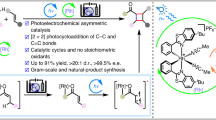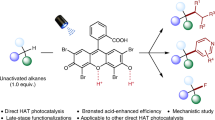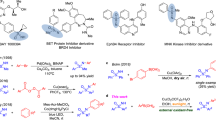Abstract
Photoelectrochemical cells are widely studied for solar energy conversion. However, they have rarely been used for the synthesis of high added-value organic molecules. Here we describe a strategy to use haematite, an abundant and robust photoanode, for non-directed arene C–H amination. Under illumination, the photogenerated holes in haematite oxidize electron-rich arenes to radical cations, which further react with azoles to give nitrogen heterocycles of medicinal interest. Unusual ortho selectivity was achieved, probably due to a hydrogen-bonding interaction between the substrates and the hexafluoroisopropanol co-solvent. The method exhibits broad scope and is successfully applied for the late-stage functionalization of several pharmaceutical molecules.
This is a preview of subscription content, access via your institution
Access options
Access Nature and 54 other Nature Portfolio journals
Get Nature+, our best-value online-access subscription
$29.99 / 30 days
cancel any time
Subscribe to this journal
Receive 12 digital issues and online access to articles
$119.00 per year
only $9.92 per issue
Buy this article
- Purchase on Springer Link
- Instant access to full article PDF
Prices may be subject to local taxes which are calculated during checkout





Similar content being viewed by others
Data availability
The data that support the plots within this paper and other findings of this study are available from the corresponding author upon reasonable request.
References
Grätzel, M. Photoelectrochemical cells. Nature 414, 338–344 (2001).
Tachibana, Y., Vayssieres, L. & Durrant, J. R. Artificial photosynthesis for solar water-splitting. Nat. Photon. 6, 511–518 (2012).
Fujishima, A. & Honda, K. Electrochemical photolysis of water at a semiconductor electrode. Nature 238, 37–38 (1972).
Cha, H. G. & Choi, K.-S. Combined biomass valorization and hydrogen production in a photoelectrochemical cell. Nat. Chem. 7, 328–333 (2015).
Li, T. et al. Photoelectrochemical oxidation of organic substrates in organic media. Nat. Commun. 8, 390 (2017).
Tateno, H., Miseki, Y. & Sayama, K. Photoelectrochemical oxidation of benzylic alcohol derivatives on BiVO4/WO3 under visible light irradiation. ChemElectroChem 4, 3283–3287 (2017).
Tateno, H., Miseki, Y. & Sayama, K. Photoelectrochemical dimethoxylation of furan via a bromide redox mediator using a BiVO4/WO3 photoanode. Chem. Commun. 53, 4378–4381 (2017).
Tateno, H., Iguchi, S., Miseki, Y. & Sayama, K. Photo-electrochemical C−H bond activation of cyclohexane using a WO3 photoanode and visible light. Angew. Chem. Int. Ed. 57, 11238–11241 (2018).
Tran, L. D., Roane, J. & Daugulis, O. Directed amination of non-acidic arene C–H bonds by a copper–silver catalytic system. Angew. Chem. Int. Ed. 52, 6043–6046 (2013).
Xu, H., Qiao, X., Yang, S. & Shen, Z. Cu-catalyzed direct amidation of aromatic C–H bonds: an access to arylamines. J. Org. Chem. 79, 4414–4422 (2014).
Matsubara, T., Asako, S., Ilies, L. & Nakamura, E. Synthesis of anthranilic acid derivatives through iron-catalyzed ortho amination of aromatic carboxamides with N-chloroamines. J. Am. Chem. Soc. 136, 646–649 (2014).
Kim, H. J., Kim, J., Cho, S. H. & Chang, S. Intermolecular oxidative C–N bond formation under metal-free conditions: control of chemoselectivity between aryl sp 2 and benzylic sp 3 C–H bond imidation. J. Am. Chem. Soc. 133, 16382–16385 (2011).
Kantak, A. A., Potavathri, S., Barham, R. A., Romano, K. M. & DeBoef, B. Metal-free intermolecular oxidative C–N bond formation via tandem C–H and N–H bond functionalization. J. Am. Chem. Soc. 133, 19960–19965 (2011).
Romero, N. A., Margrey, K. A., Tay, N. E. & Nicewicz, D. A. Site-selective arene C–H amination via photoredox catalysis. Science 349, 1326–1330 (2015).
Margrey, K. A., McManus, J. B., Bonazzi, S., Zecri, F. & Nicewicz, D. A. Predictive model for site-selective aryl and heteroaryl C–H functionalization via organic photoredox catalysis. J. Am. Chem. Soc. 139, 11288–11299 (2017).
Niu, L. et al. Photo-induced oxidant-free oxidative C–H/N–H cross-coupling between arenes and azoles. Nat. Commun. 8, 14226 (2017).
Song, C. et al. Visible-light-mediated C2-amination of thiophenes by using DDQ as an organophotocatalyst. Chem. Commun. 53, 3689–3692 (2017).
Das, S., Natarajan, P. & König, B. Teaching old compounds new tricks: DDQ-photocatalyzed C−H amination of arenes with carbamates, urea, and N-heterocycles. Chem. Eur. J. 23, 18161–18165 (2017).
Sauermann, N., Mei, R. & Ackermann, L. Electrochemical C−H amination by cobalt catalysis in a renewable solvent. Angew. Chem. Int. Ed. 57, 5090–5094 (2018).
Gao, X., Wang, P., Zeng, L., Tang, S. & Lei, A. Cobalt(ii)-catalyzed electrooxidative C–H amination of arenes with alkylamines. J. Am. Chem. Soc. 140, 4195–4199 (2018).
Yang, Q.-L. et al. Copper-catalyzed electrochemical C–H amination of arenes with secondary amines. J. Am. Chem. Soc. 140, 11487–11494 (2018).
Morofuji, T., Shimizu, A. & Yoshida, J.-I. Electrochemical C–H amination: synthesis of aromatic primary amines via N-arylpyridinium Ions. J. Am. Chem. Soc. 135, 5000–5003 (2013).
Morofuji, T., Shimizu, A. & Yoshida, J.-I. Direct C–N coupling of imidazoles with aromatic and benzylic compounds via electrooxidative C–H functionalization. J. Am. Chem. Soc. 136, 4496–4499 (2014).
Morofuji, T., Shimizu, A. & Yoshida, J.-I. Heterocyclization approach for electrooxidative coupling of functional primary alkylamines with aromatics. J. Am. Chem. Soc. 137, 9816–9819 (2015).
Morofuji, T., Shimizu, A. & Yoshida, J.-I. Electrochemical intramolecular C−H amination: synthesis of benzoxazoles and benzothiazoles. Chem. Eur. J. 21, 3211–3214 (2015).
Tamirat, A. G., Rick, J., Dubale, A. A., Su, W.-N. & Hwang, B.-J. Using hematite for photoelectrochemical water splitting: a review of current progress and challenges. Nanoscale Horiz. 1, 243–267 (2016).
Sivula, K., Le Formal, F. & Grätzel, M. Solar water splitting: progress using hematite (α-Fe2O3) photoelectrodes. ChemSusChem 4, 432–449 (2011).
Tilley, S. D., Cornuz, M., Sivula, K. & Grätzel, M. Light-induced water splitting with hematite: improved nanostructure and iridium oxide catalysis. Angew. Chem. Int. Ed. 49, 6405–6408 (2010).
Kirste, A., Elsler, B., Schnakenburg, G. & Waldvogel, S. R. Efficient anodic and direct phenol–arene C,C cross-coupling: the benign role of water or methanol. J. Am. Chem. Soc. 134, 3571–3576 (2012).
Wiebe, A. et al. Electrifying organic synthesis. Angew. Chem. Int. Ed. 57, 5594–5619 (2018).
Elsler, B. et al. Source of selectivity in oxidative cross-coupling of aryls by solvent effect of 1,1,1,3,3,3-hexafluoropropan-2-ol. Chem. Eur. J. 21, 12321–12325 (2015).
Bechgaard, K. & Parker, V. D. Mono-, di-, and trications of hexamethoxytriphenylene. Novel anodic trimerization. J. Am. Chem. Soc. 94, 4749–4750 (1972).
Schubert, M. et al. Over-oxidation as the key step in the mechanism of the MoCl5-mediated dehydrogenative coupling of arenes. Angew. Chem. Int. Ed. 55, 1156–1159 (2016).
Grundy, S. M., Ahrens, E. H., Salen, G., Schreibman, P. H. & Nestel, P. J. Mechanisms of action of clofibrate on cholesterol metabolism in patients with hyperlipidemia. J. Lipid Res. 13, 531–551 (1972).
See, S. & Ginzburg, R. Skeletal muscle relaxants. Pharmacotherapy 28, 207–213 (2008).
Sickbert-Bennett, E. E. et al. Comparative efficacy of hand hygiene agents in the reduction of bacteria and viruses. Am. J. Infect. Control 33, 67–77 (2005).
Colomer, I., Chamberlain, A. E. R., Haughey, M. B. & Donohoe, T. J. Hexafluoroisopropanol as a highly versatile solvent. Nat. Rev. Chem. 1, 0088 (2017).
Eberson, L., Persson, O. & Hartshorn, M. P. Detection and reactions of radical cations generated by photolysis of aromatic compounds with tetranitromethane in 1,1,1,3,3,3-hexafluoro-2-propanol at room temperature. Angew. Chem. Int. Ed. Engl. 34, 2268–2269 (1995).
Eberson, L., Hartshorn, M. P., Persson, O. & Radner, F. Making radical cations live longer. Chem. Commun. 0, 2105–2112 (1996).
Berkessel, A., Adrio, J. A., Hüttenhain, D. & Neudörfl, J. M. Unveiling the ‘booster effect’ of fluorinated alcohol solvents: aggregation-induced conformational changes and cooperatively enhanced H-bonding. J. Am. Chem. Soc. 128, 8421–8426 (2006).
Colomer, I., Batchelor-McAuley, C., Odell, B., Donohoe, T. J. & Compton, R. G. Hydrogen bonding to hexafluoroisopropanol controls the oxidative strength of hypervalent iodine reagents. J. Am. Chem. Soc. 138, 8855–8861 (2016).
Ben-Daniel, R., de Visser, S. P., Shaik, S. & Neumann, R. Electrophilic aromatic chlorination and haloperoxidation of chloride catalyzed by polyfluorinated alcohols: a new manifestation of template catalysis. J. Am. Chem. Soc. 125, 12116–12117 (2003).
Berkessel, A. & Adrio, J. A. Kinetic studies of olefin epoxidation with hydrogen peroxide in 1,1,1,3,3,3-hexafluoro-2-propanol reveal a crucial catalytic role for solvent clusters. Adv. Synth. Catal. 346, 275–280 (2004).
de Visser, S. P., Kaneti, J., Neumann, R. & Shaik, S. Fluorinated alcohols enable olefin epoxidation by H2O2: template catalysis. J. Org. Chem. 68, 2903–2912 (2003).
Morales-Guio, C. G. et al. An optically transparent iron nickel oxide catalyst for solar water splitting. J. Am. Chem. Soc. 137, 9927–9936 (2015).
Al-Awadi, S. A. et al. Kinetics and mechanism of thermal gas-phase elimination of β-substituted carboxylic acids. Tetrahedron 61, 5769–5777 (2005).
Ankner, T. & Hilmersson, G. Instantaneous deprotection of tosylamides and esters with SmI2/amine/water. Org. Lett. 11, 503–506 (2009).
Acknowledgements
This work was supported by the EPFL, a consolidator grant from the European Research Council under the European Union’s Horizon 2020 research and innovation programme (no. 681292 to X.H.), the PECHouse3 project from the Swiss Federal Office of Energy (no. SI/500090-03, M.G. and J.L.), the Strategic Japanese–Swiss Science and Technology Programme from the Swiss National Science Foundation (no. 514259, M.G. and J.L.) and the Chinese Thousand Talents Program for Young Professionals (J.L.).
Author information
Authors and Affiliations
Contributions
X.H. directed the project. L.Z. conceived and performed most of experiments. L.L. prepared the haematites and conducted the EIS analysis. J.L. and D.R. measured the IPCE. X.H. and L.Z. wrote the paper, with input from others. All the authors analysed the results and reviewed the paper.
Corresponding author
Ethics declarations
Competing Interests
The authors declare no competing interests.
Additional information
Publisher’s note: Springer Nature remains neutral with regard to jurisdictional claims in published maps and institutional affiliations.
Supplementary information
Supplementary information
Supplementary Methods, Supplementary References, Supplementary Figures 1–6
Rights and permissions
About this article
Cite this article
Zhang, L., Liardet, L., Luo, J. et al. Photoelectrocatalytic arene C–H amination. Nat Catal 2, 366–373 (2019). https://doi.org/10.1038/s41929-019-0231-9
Received:
Accepted:
Published:
Issue Date:
DOI: https://doi.org/10.1038/s41929-019-0231-9
This article is cited by
-
Electrophotocatalytic hydrogenation of imines and reductive functionalization of aryl halides
Nature Communications (2024)
-
Approaches to Improving Selectivity During Photoelectrochemical Transformation of Small Molecules
Transactions of Tianjin University (2024)
-
Electric-field-controlled highly regioselective thiocyanation of N-containing heterocycles
Science China Chemistry (2024)
-
Photoelectrochemical oxidative C(sp3)−H borylation of unactivated hydrocarbons
Nature Communications (2023)
-
Electrophotocatalytic oxygenation of multiple adjacent C–H bonds
Nature (2023)



